Blogs
Regular Inspections:
Check the plant regularly for signs of disease, nutrient deficiencies, or other issues. Early detection allows for timely intervention.
Patience:
Be patient while curry leaf plants can grow relatively fast under optimal conditions. Growth rates can vary; some plants may take time to establish before showing vigorous growth.
Also Read This : Growing Syngonium Plants at Home: A Simple Guide Using Cuttings and Seeds
By incorporating these tips into your care routine, you can encourage your curry leaf plant to flourish, providing you with a bountiful supply of healthy and flavorful leaves for your culinary endeavours.







